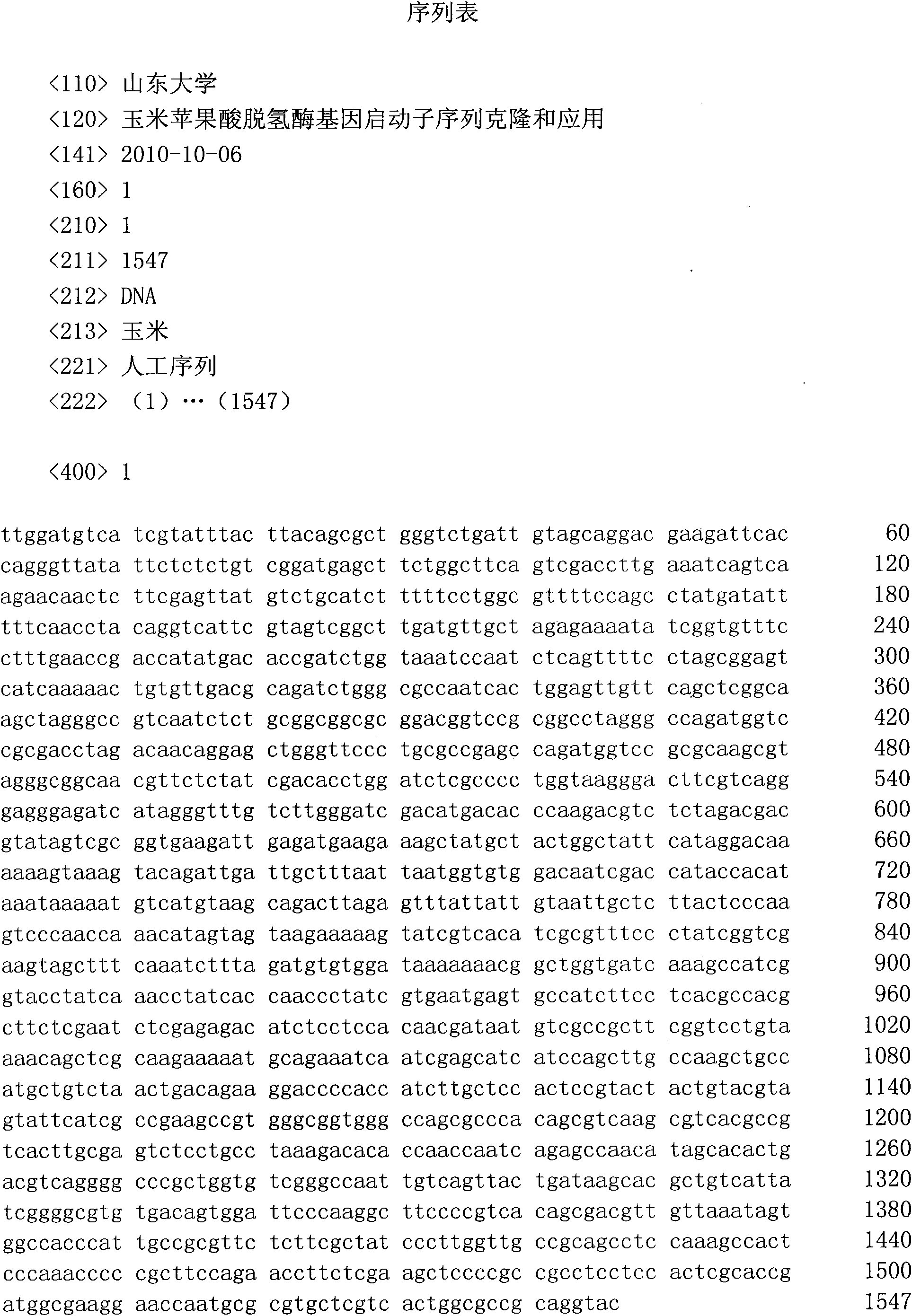Cloning and application of promoter sequence of corn malate dehydrogenase gene
A malate dehydrogenase and promoter sequence technology, applied in the field of plant bioengineering breeding, can solve the problems of gene promoter cloning and application that have not yet been seen
- Summary
- Abstract
- Description
- Claims
- Application Information
AI Technical Summary
Problems solved by technology
Method used
Image
Examples
Embodiment 1
[0036] Example 1: Transformation of PZmMDH::TPT1 sense gene to create wheat high-efficiency materials
[0037] The phosphorus transport between plant cytoplasm and chloroplast stroma is mainly responsible for the triose-phosphate / phosphate translocator (TPT), which can transport phosphorus from the cytoplasm to the chloroplast; at the same time, etc. Moles of triosephosphate 3-PGA are transported from the chloroplast stroma into the cytoplasm. However, when the cytoplasmic phosphorus concentration is reduced, the activity of the TPT transporter is inhibited, resulting in the accumulation of metabolites in the chloroplast. The TPT gene used in this example is the maize ZmTPT1 gene.
[0038] 1. Construction of fusion gene and plant expression vector
[0039] Specific primers were used to carry out PCR reaction with maize genomic DNA as a template, and the coding frames and 3' end sequences of PZmMDH and ZmTPT1 were obtained respectively. Electrophoresis analysis of amplificat...
Embodiment 2
[0057] Example 2: Transformation of PZmMDH::Bt toxin gene to create corn insect-resistant inbred lines and its application
[0058] 1. Construction of PZmMDH::Bt toxin fusion gene and plant expression vector
[0059]Fusion gene construction adopts conventional DNA recombination technology. According to the cloned PZmMDH and Bt toxin gene sequence, the PCR method is used to introduce a suitable enzyme cutting site, and the fusion gene is generated by restriction endonuclease digestion and sticky end connection. After the fusion gene was verified to be correctly constructed by sequencing, it was recombined into a plant expression vector and used to transform Agrobacterium to obtain an engineering strain whose Ti plasmid T-DNA region contained a transgenic plant selection marker and a target gene. The latter can be used for genetic transformation of plants.
[0060] 2. Establishment of receptor system
[0061] The main inbred lines used in my country's agricultural production ...
Embodiment 3
[0076] Example 3: Transforming the PZmMDH::CA1 gene to create a high-efficiency maize inbred line and its application
[0077] A large number of studies have concluded that in C3 plants, the C3 cycle is completed in single cells, and CO in the atmosphere 2 Carboxylation catalyzed by Rubisco directly enters the Calvin cycle, while the C4 cycle is completed cooperatively in mesophyll cells and bundle sheath cells. First, in mesophyll cells, CO 2 to HCO 3 - The form of phosphoenolpyruvate carboxylase (PEPCase) catalyzed immobilization to form C4 dicarboxylic acid-oxaloacetic acid (OAA), which was then reduced to malic acid (Mal), and then transferred to In bundle sheath cells, CO is rapidly re-released under the catalysis of decarboxylase 2 , participate in the Calvin cycle to form sugars; secondly, the pyruvate (pyruvate, Pyr) produced while releasing CO2 is transferred to the chloroplast of the mesophyll cell, and is catalyzed by pyruvate orthophosphate dikinase (PPDK) to g...
PUM
 Login to View More
Login to View More Abstract
Description
Claims
Application Information
 Login to View More
Login to View More - R&D
- Intellectual Property
- Life Sciences
- Materials
- Tech Scout
- Unparalleled Data Quality
- Higher Quality Content
- 60% Fewer Hallucinations
Browse by: Latest US Patents, China's latest patents, Technical Efficacy Thesaurus, Application Domain, Technology Topic, Popular Technical Reports.
© 2025 PatSnap. All rights reserved.Legal|Privacy policy|Modern Slavery Act Transparency Statement|Sitemap|About US| Contact US: help@patsnap.com

